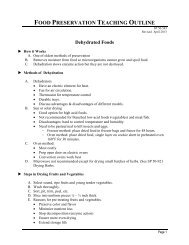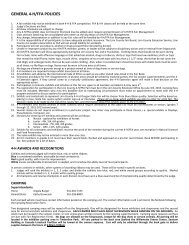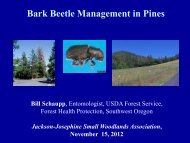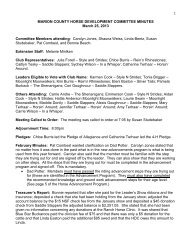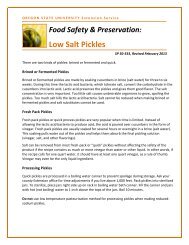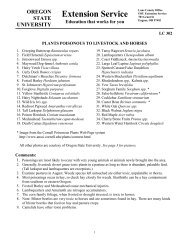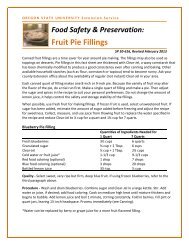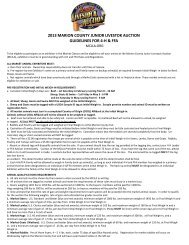What Can I Do With My Small Farm - Oregon State University ...
What Can I Do With My Small Farm - Oregon State University ...
What Can I Do With My Small Farm - Oregon State University ...
You also want an ePaper? Increase the reach of your titles
YUMPU automatically turns print PDFs into web optimized ePapers that Google loves.
For more detailed information<br />
on crops and<br />
returns, visit the National<br />
Agricultural Statistics<br />
Service Web site at<br />
http://www.nass.usda.<br />
gov/. They have information<br />
for each state by<br />
commodity with some<br />
historical data. <strong>What</strong><br />
you won’t fi nd easily is<br />
detailed information on<br />
very specialized crops.<br />
In addition, enterprise<br />
budgets are available for<br />
many crops. They contain<br />
useful information<br />
on the costs of specifi c<br />
activities involved in<br />
producing and marketing<br />
a crop.<br />
Contact your county<br />
Extension offi ce for more<br />
information or visit the<br />
OSU Extension Publications<br />
and Videos catalog<br />
at http://extension.<br />
oregonstate.edu/<br />
catalog.<br />
Before you invest any signifi cant<br />
amount of money in a crop, you<br />
should know the crop’s biology,<br />
production technology, and<br />
marketing options in some depth.<br />
6 <strong>What</strong> <strong>Can</strong> I <strong>Do</strong> with my <strong>Small</strong> <strong>Farm</strong>?<br />
small farmers. These values offer excellent comparisons and<br />
are a good place to start.<br />
If you are seriously considering a crop, you should know<br />
the equipment requirements and develop a cash-fl ow budget<br />
for each year in the production cycle. Pay particular<br />
attention to harvest and marketing costs. For example,<br />
blueberries usually cost 22–28 cents/pound to harvest and<br />
transport. A heavy crop requires more up-front cash for harvesting<br />
and delivering the crop to market than does a lighter<br />
crop.<br />
<strong>What</strong> stands out from Table 1?<br />
Clearly, there are a lot of options to generate $100/acre. As<br />
your expectations go up, the crop choices that will meet<br />
those expectations diminish, and the investment and<br />
skills needed increase. If you want to generate gross sales<br />
of $1,000/acre, beef, hay, or grains are not viable options.<br />
Other crops do show signifi cant income potential.<br />
Assume the direct operating expenses on most crops are<br />
50–60 percent of gross sales. For example, how much will<br />
it take to raise an acre of nursery stock? You must include<br />
capital investment in facilities (such as greenhouses and<br />
winter houses) as well as all operating expenses (fertilizer,<br />
labor, crop protection products, and marketing costs).<br />
This is cash up front, and $5,000 to $9,000 is a bare<br />
minimum!<br />
The profi tability of any farming enterprise, large or small,<br />
is very diffi cult to predict. You must identify what you mean<br />
by profi tability. <strong>Do</strong>es it mean just staying in the black for a<br />
specifi c crop? <strong>Do</strong>es it mean providing a small supplemental<br />
income? <strong>Do</strong>es it mean providing a full family income? <strong>Small</strong><br />
farms can provide all of the above, given good resources and<br />
skills.<br />
The physical resources<br />
of the farm<br />
Not all farms are created equal. They vary widely in the<br />
types of crops they can grow. A farm’s capability to grow<br />
various crops is related to its physical resources: soils, access<br />
to irrigation water, and climate. These physical resources<br />
might seriously restrict the types of crops that can be grown<br />
or might provide nearly unlimited options. Successful farming<br />
includes the ability to match crop options to your farm’s<br />
capability.<br />
Land—types of soils<br />
Soils are complex mixtures of sand, silt, and clay. The<br />
relative abundance of these soil components determines<br />
which soil type you have. The types of soils on your farm







